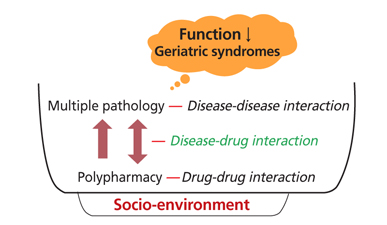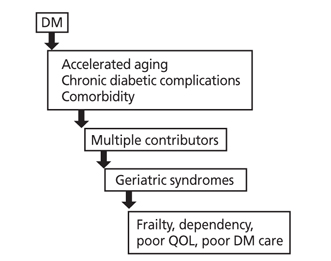J Korean Med Assoc.
2014 Sep;57(9):738-742. 10.5124/jkma.2014.57.9.738.
Clinical implications of geriatric syndromes
- Affiliations
-
- 1Division of Endocrinology & Geriatrics, Department of Internal Medicine, Hallym University College of Medicine, Seoul, Korea. hjyoo@hallym.or.kr
- KMID: 2459281
- DOI: http://doi.org/10.5124/jkma.2014.57.9.738
Abstract
- A decline in organ function, accompanying risk factors, and diseases altogether make disease presentation-diagnosis-management obscure. Geriatric clinical situations are rarely simple. Geriatric syndromes are clinical conditions that are highly prevalent in aged persons, have multifactorial pathophysiology, and associated with considerable morbidity and poor quality of life. Geriatric syndromes are associated with increased risk of activities of daily livings) loss and death rate. There are 3 approaches to Geriatric syndrome management, such as traditional approach by diagnosis and treatment, geriatric approach by risk factor assessment and reduction, and 'mom' approach through 3 domains. In older patients, complicated associations of multiple contributors generally cause a single symptom, which is accompanied and accumulated by multiple impairments. The management of geriatric syndromes includes the treatment of multiple contributors, the treatment of one geriatric symptom or sign, the management of multiple outcomes, and prevention. I'd like to name this approach as 'mom' approach after the acronym of multiple contributors, one phenotype, and multiple outcomes. The understanding of geriatric syndromes will be an important stepping stone in clinical practice of geriatrics.
Figure
Cited by 3 articles
-
Why Geriatric Medicine Is Important for Korea: Lessons Learned in the United States
Chang Won Won, Sunyoung Kim, Daniel Swagerty
J Korean Med Sci. 2018;33(26):. doi: 10.3346/jkms.2018.33.e175.Regional anesthetic management of elderly patients
Kyung-Hwa Kwak, Sung Sik Park
J Korean Med Assoc. 2017;60(5):377-383. doi: 10.5124/jkma.2017.60.5.377.Geriatric Syndrome and Mortality among Community-dwelling Older Adults in Korea: 3-year Follow-up Study
Si Eun Lee, Gwi-Ryung Son Hong
Korean J Adult Nurs. 2017;29(1):98-107. doi: 10.7469/kjan.2017.29.1.98.
Reference
-
1. Yoo HJ. The characteristics of elderly patients. In : Yoo HJ, editor. Geriatric medicine. Seoul: Seoul National University Press;1998. p. 67–72.2. Yoo HJ. What is geriatric disease? J Korean Geriatr Soc. 2008; 12:61–67.3. Rhee JA, Yoo HJ. Health status of elderly Koreans. In : Choi SJ, editor. Aging in Korea: today and tomorrow. 3rd ed. Seoul: Elderly Information Center;2013. p. 52–66.4. Goodwin JS. Geriatrics and the limits of modern medicine. N Engl J Med. 1999; 340:1283–1285.
Article5. Yoo HJ. Korean Geriatrics Society. An introduction to geriatrics. Geriatrics. 2nd ed. Seoul: Medical Publishing;2005. p. 22–25.6. Olde Rikkert MG, Rigaud AS, van Hoeyweghen RJ, de Graaf J. Geriatric syndromes: medical misnomer or progress in geriatrics? Neth J Med. 2003; 61:83–87.7. Toba K. Geriatric syndrome. In : Toba K, editor. How to treat for the geriatric syndrome. 1st ed. Tokyo: Medical View;2005. p. 2–6.8. Yoo HJ. Geriatric syndromes: a core geriatric concept. J Korean Geriatr Soc. 2009; 13(S2):15–19.9. Yoo HJ. Geriatric syndromes: a geriatric characteristic. Korean J Med. 2009; 77(S4):1073–1076.10. Ferrucci L, Studenski S. Clinical problems of aging. In : Harrison TR, Wiener CM, Brown CD, Hemnes AR, editors. Harrison's principles of internal medicine. 18th ed. New York: McGraw Hill;2012. p. 579–581.11. Won CW, Yoo HJ, Yu SH, Kim CO, Dumlao LC, Dewiasty E, Rowland J, Chang HH, Wang J, Akishita M, Tan TL, Lum C, Prakash O. Lists of geriatric syndromes in the Asian-Pacific geriatric societies. Eur Geriatr Med. 2013; 4:335–338.
Article12. Elsawy B, Higgins KE. The geriatric assessment. Am Fam Physician. 2011; 83:48–56.13. Inouye SK, Studenski S, Tinetti ME, Kuchel GA. Geriatric syndromes: clinical, research, and policy implications of a core geriatric concept. J Am Geriatr Soc. 2007; 55:780–791.
Article14. Kane RL, Shamliyan T, Talley K, Pacala J. The association between geriatric syndromes and survival. J Am Geriatr Soc. 2012; 60:896–904.
Article15. Yoo HJ. Treatment of geriatric syndromes. J Korean Geriatr Soc. 2010; 14(S3):78–80.16. Champion A. Anorexia of aging. Ann Longterm Care. 2011; 19:18–24.17. Morley JE. Anorexia of aging: a true geriatric syndrome. J Nutr Health Aging. 2012; 16:422–425.
Article18. Yoo HJ. Fall in the elderly. Korean Orthopedic Association. Orthopedics. 7th ed. Seoul: Korean Orthopedic Association;2013. p. 1699–1702.19. Hanley A, Silke C, Murphy J. Community-based health efforts for the prevention of falls in the elderly. Clin Interv Aging. 2011; 6:19–25.
Article20. Phelan EA, Vig EK, Abrass IB. Some considerations regarding geriatric syndromes. Ann Intern Med. 2001; 135:1095.
Article21. Kudo H, Kudo H, Watanabe M, Kodama H, Izumo Y, Sasaki H. A new approach for geriatric syndrome. Nihon Ronen Igakkai Zasshi. 2008; 45:18–21.
Article22. Strandberg TE, Pitkala KH, Tilvis RS, O'Neill D, Erkinjuntti TJ. Geriatric syndromes: vascular disorders? Ann Med. 2013; 45:265–273.
- Full Text Links
- Actions
-
Cited
- CITED
-
- Close
- Share
- Similar articles
-
- Co-occurrence of Chronic Diseases and Geriatric Syndromes
- Comprehensive Approach for Managing the Older Person with Diabetes Mellitus
- Frailty Screening and Detection of Geriatric Syndromes in Acute Inpatient Care: Impact on Hospital Length of Stay and 30-Day Readmissions
- Comprehensive Geriatric Assessment for Evaluating the Health Status of Older Adults
- Comprehensive geriatric assessment for the evaluation of the health statuses of elderly patients





